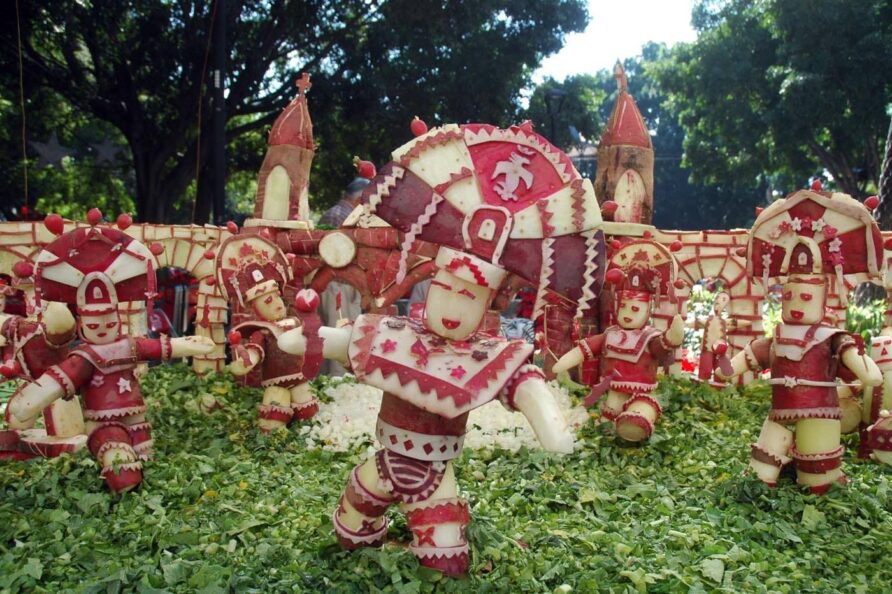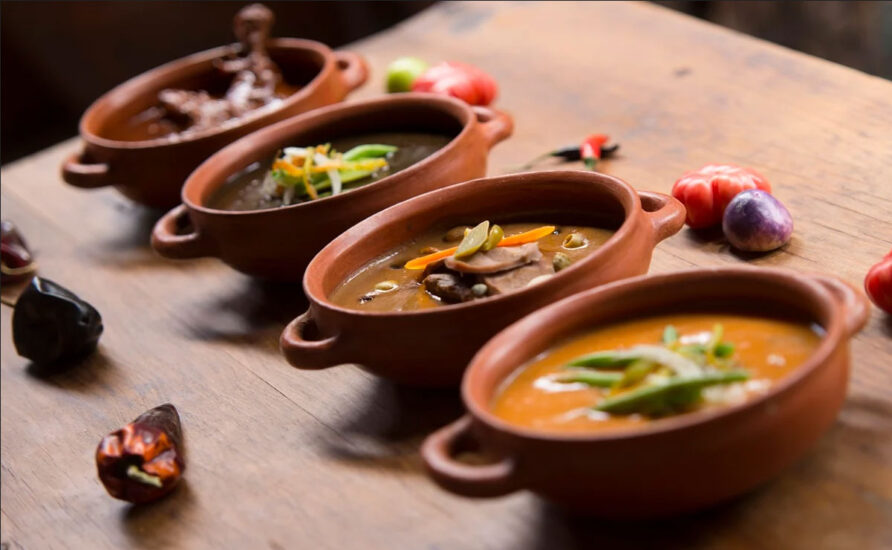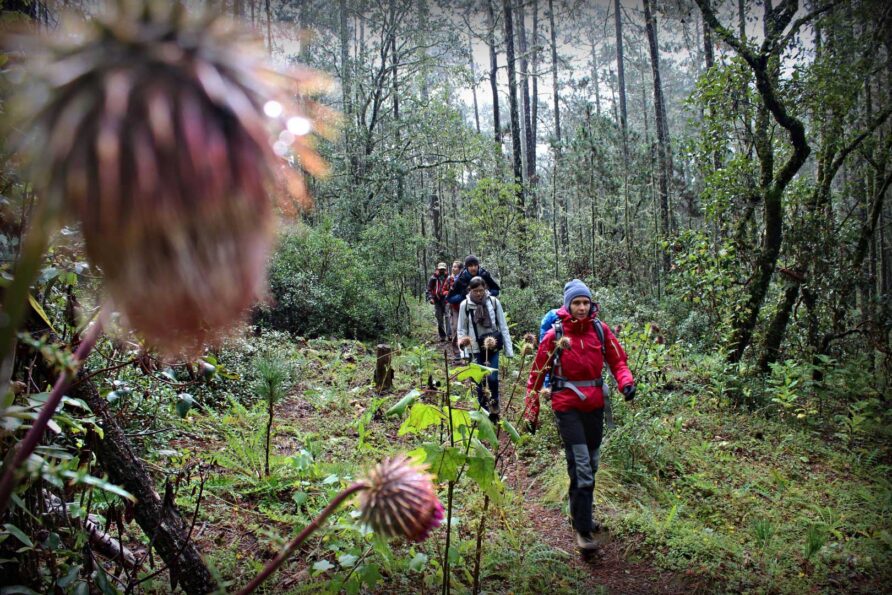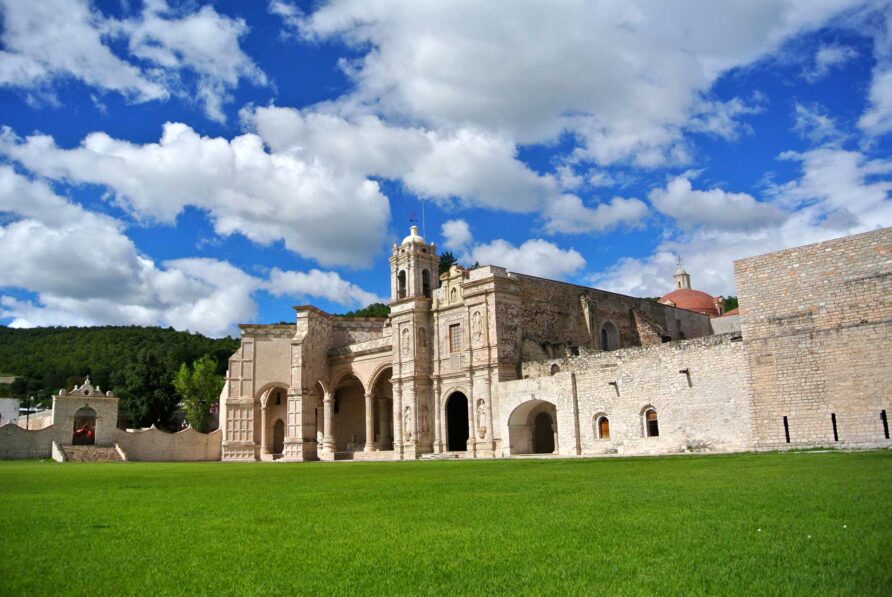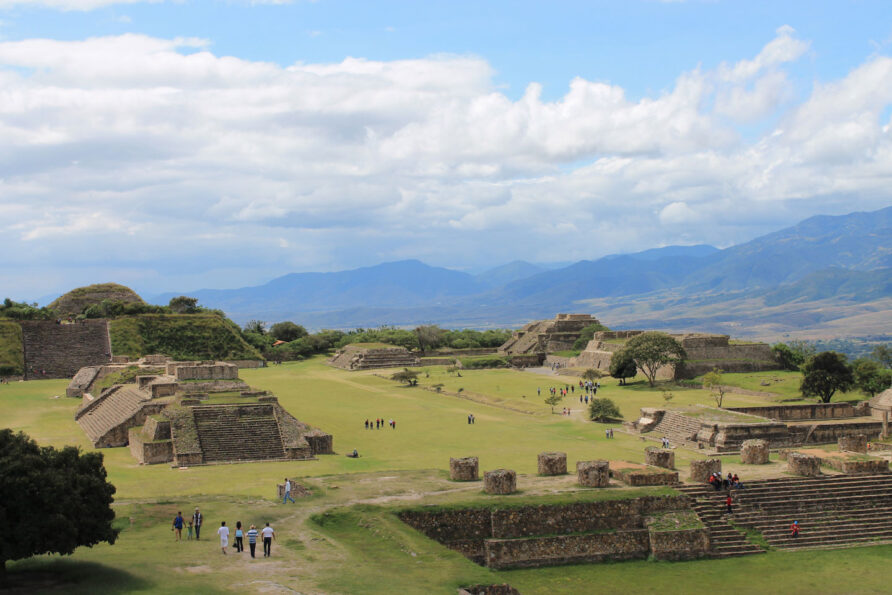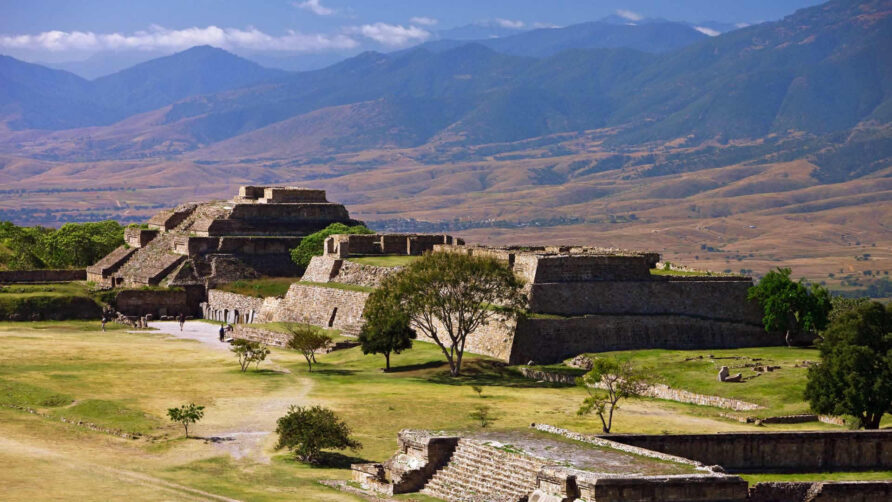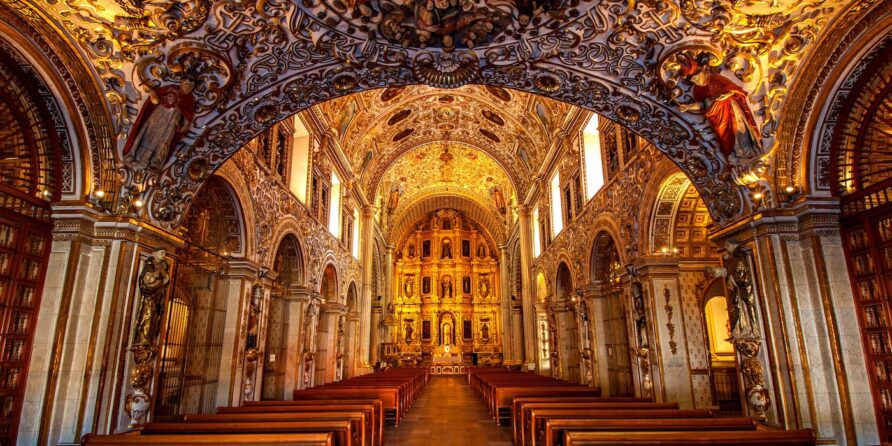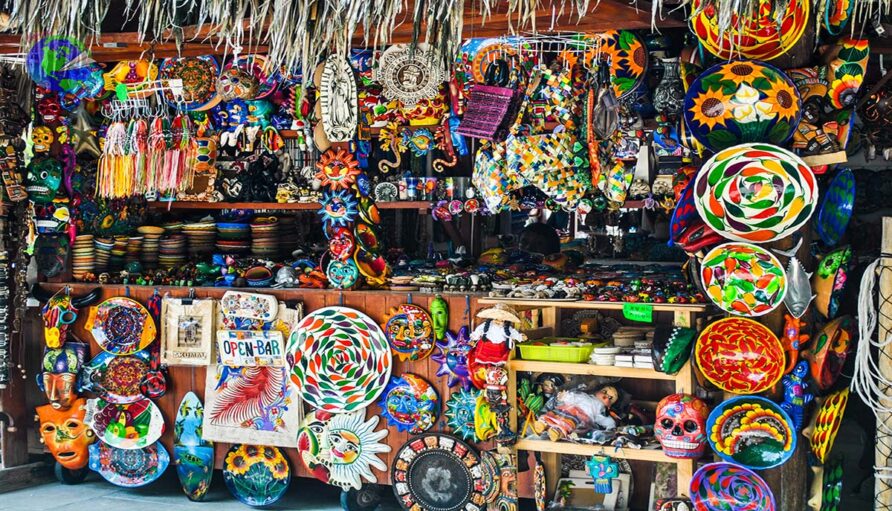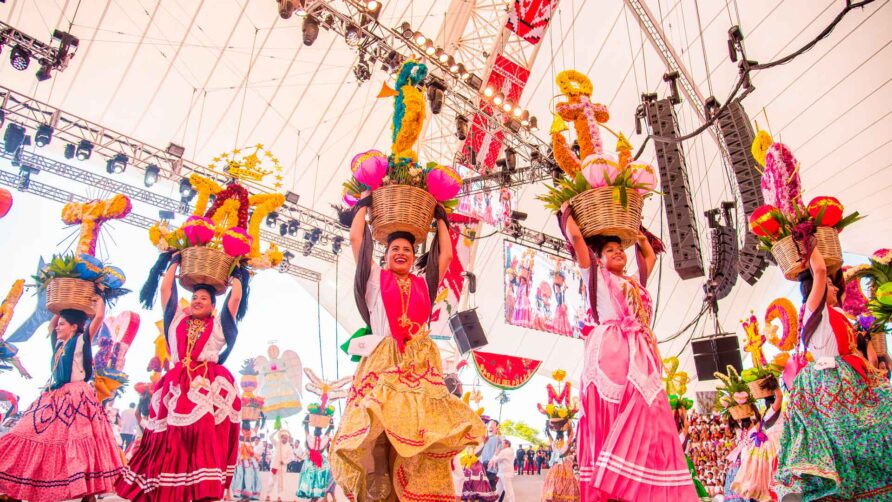In the state of Oaxaca there are many customs and traditions throughout the year, and within the state, said that they have the same purpose of celebration but with different things, in fact from one region to another or even more from one town to another, the Customs vary for perhaps details but that is what makes them authentic. All the holidays are celebrated, the profane and the religious ones. The festival calendar is extensive due to the diversity of ethnic groups, which they still conserve.
Oaxaca It has a combination in its traditions of the culture of the ancestors and the current culture, a state that does not lose its customs, adapts them to new times and needs.

The Guelaguetza
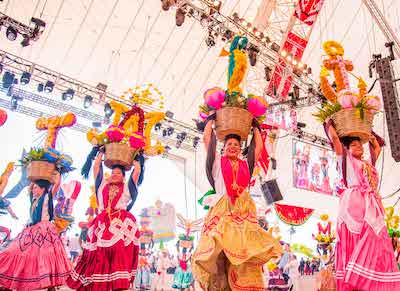
Monday of the hill in the city of Oaxaca. La Guelaguetza is one of the most important traditions in Oaxaca. Its name is derived from the Zapotec word "Guendalezaa" which means "offering, present, fulfillment." This festival is a great ethnic and cultural mosaic that is expressed in multiple languages, dances, songs, dresses and customs of the Oaxacan people. The celebration has acquired world renown and has the participation of the eight folkloric regions of the State: La Costa, La Cañada, La Mixteca, La Sierra Norte, Sierra Sur, Papaloapan, El Istmo and Los Valles Centrales.
In an auditorium in the Cerro del Fortín, they offer their main traditional dances and dances, along with characteristic products of their land such as fruits or handicrafts. The festivities include other shows starting with the parade of the delegations organized in the manner of the traditional Calenda. In the same auditorium where the Guelaguetza takes place, the Legend of Princess Donají, daughter of the Zapotec King Cosijoezay of Princess Coyolicatzin, is presented, a presentation full of drama, light, sound and fireworks.
The festival is complemented with gastronomic and handicraft samples, traditional representations of the most diverse communities in the state, exhibitions, concerts and cultural events.
La Guelaguetza is celebrated every year on the two Mondays after July 16, except when the first Monday falls on July 18, Benito Juárez's death anniversary. In that case, the celebrations are postponed for a week.
The venue for the celebration is the Guelaguetza Auditorium where various art, dance, music and theater events take place throughout the year. This enclosure is located in Cerro del Fortín and was built of green quarry. Its semicircular design reminiscent of ancient Greek theaters, takes advantage of the slope of the land to place the stands. Although the auditorium has a canvas roof, it is recommended to bring sun protection and a hat. It has a capacity of 11,000 spectators and has a beautiful view of the City of Oaxaca and the Valleys.

Night of rabanos

The tradition of Night of rabanos It comes from colonial times, when the natives learned to harvest large radishes that were grown in the region. It is a popular festival that is celebrated on the night of December 23th in the capital city square, where figures and scenes sculpted using only these delicious bulbs are displayed.
During the celebration it is customary to consume donuts and break the plates where they are served: depending on the number of pieces in which the dish is broken, it will be the fate of the diner for the following year.
The Night of Radishes is a traditional Oaxacan festival with a clearly popular stamp in which market gardeners and flower growers display the artistic talent of their hands with special designs made of radish, immortal flower and totomoxtle. The exhibition lasts only a few hours, but it brings together practically all the inhabitants of the city in the zócalo area, who attend in order to admire the creativity of the participants in this contest that takes place year after year on December 23.
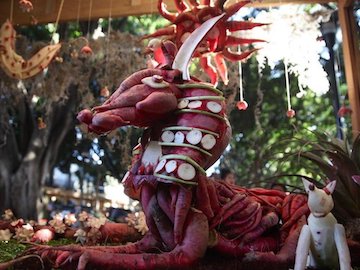
Some authors mention colonial vegetable competitions, the friars (in particular the Dominicans) were the ones who taught the cultivation of flowers and vegetables, some brought from Spain to the groups of naborías (indigenous Zapotecs and Mixtecs) who served in the houses of the neighbors. On July 7, 1563, they were granted by order of Viceroy Luis de Velasco, the lands near the estates of La Noria and Cinco Señores, thus founding the town of Trinidad de las Huertas or de las Naborías. It was in this place that all the farmers dedicated to horticulture and floriculture were grouped.
Regarding its origin, various versions agree that the custom of radishes and their original designs have their roots in the Christmas Vigil market that was held precisely every 23 December.
The ancient way of the Oaxacans was to attend the calends and the mass of Gallo. Christmas dinner came much later. The merchants used to sell salty dried fish in the Plaza de Armas de la Vieja Antequera, essential for waking meals, as well as the vegetables needed to complement the menu. The market gardeners of Trinidad de las Huertas brought their vegetables, selling them in stalls set up for this purpose.
In order to make their stalls more attractive, the gardeners began to create figures with the radishes, adorning them with cauliflower leaves and flowers made from young onions. They placed radishes, lettuces, turnips, onions, etc., all in an artistic way, without forgetting the flower baskets, which were cultivated with care.
This habit was taking root, more and more with the passage of time, reaching a point that housewives looked for these figures to decorate their tables. According to reliable sources in the book “Noche de Rábanos” written by Professor Alejandro Méndez Aquino, it is known that on December 23, 1897, the then Municipal President, Don Francisco Vasconcelos Flores, organized the first exhibition in which horticulturists participated, exposing their unique and curious creations with radishes in the form of Christmas representations, people, animals, dances and other types of scenes that their imagination dictated.
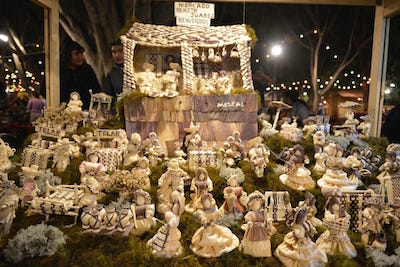
At that time in the history of Oaxaca, the first outdoor exhibition of the Night of Radishes was held in the Plaza del Marqués or Plaza de las Armas, today Plaza de la Constitución. After the first floriculture contest, it became customary for it to be held year after year.
Some time ago two more categories were proposed; Immortal Flower and Totomoxtle; The Immortal Flower is a flower of the region that through a natural process dehydrates and with it a great variety of traditional figures and ornaments are made. The Totomoxtle is the shell or leaf that covers the corn; The leaf is also dried naturally and with them figures are made with motifs similar to those of the radish and the immortal flower.

Day of the Dead
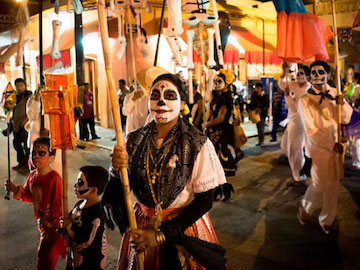
He Day of the Dead is a Mexican celebration that honors the deceased on the day November 2, starts from November 1st, and coincides with Catholic celebrations with the day of the faithful departed and all saints.
In this celebration it is customary to make Altars with offerings that is to say: Food, drinks, flowers that our deceased liked with images of the saints and photographs of them. placing candles to light his path; one of their beliefs is that a glass of water should be placed on it because the deceased arrive tired from their journey.
The celebration of the Days of the Dead in Oaxaca is a popular ceremony that invokes the spirits of the ancestors to invite them to "live together" in the earthly world, so they are treated in the most attentive way.
His visit among us obeys a permission obtained from the beyond so that the souls of the deceased can visit their relatives. The dead return home because they are attracted by their old belongings or by the love of their relatives.
It is possible to assure that no population of Mexico remains indifferent to such an ingrained tradition that in some way strengthens family ties by evoking the memory of loved ones.
There are vestiges of representations of death carried out by the various cultures that flourished before the arrival of the Spanish. These cultures maintained that with the cold winds from the north, the spirits of their dead came to visit them and to receive them they organized parties in their honor.
Since the evangelization of Oaxaca carried out by the Dominicans Fray Gonzalo Lucero and Fray Bernardino de Minaya, at the head of countless civilizing missionaries; The dates to celebrate the Faithful Departed were implemented, taking as a result of the cult of the dead that the aboriginal peoples already had and the prayers of the Church for the ancestors.

Currently, the celebration of the Dead begins in mid-October with the purchase of the products that will be placed as an offering on an altar. From very early on, the markets are installed and are dressed in characteristic smells and colors, then the gathering of relatives begins.
It can be found among the characteristic products of the season: black mole, Oaxacan sweets, among which canned pumpkin, manzanitas de tejocote and nicuatole, accompanied by chocolate and pan de muerto. All this and the fruits of the season are elements that are used to decorate the Altars of the Dead and to surround the offerings that are placed in honor of those who have already left this world.
The first of November is the day of "carrying the dead", the custom consists in giving to relatives and friends of the family a gifted sample of the foods that make up the offering of the dead. Delivery is made house to house. This day the "little angels" are worshiped, that is to say, the relatives who died as children. On the second of November the deceased adults are venerated.
Altars Cult
All Saints and the Faithful Departed are occasions for our people to exercise their ancestral customs. Some, praying for their past relatives, others going to cemeteries to decorate the graves that remain in the pantheons, thus preparing the ALTARS OF THE DEAD.
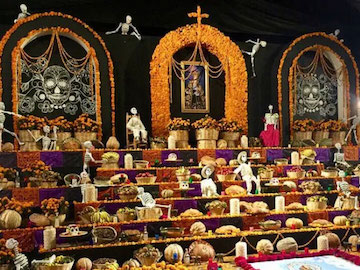
Much of the preparation of these festivals is reflected in the construction of the Altares de Muertos, an offering that is made to honor deceased relatives, since according to popular belief, they will come to visit their homes and their families on this day. . The Altars of the Dead are installed in the houses of their relatives or in the same pantheons on the tombs and vary according to the traditions of each region. Everything that the deceased enjoyed in life is remembered when preparing the altar; The offering is placed on October 31 in the morning, and it is everything that the relatives will come to savor and enjoy.
These altars are generally raised on a table lined with a tablecloth or a white sheet or with "chopped" china paper; On the front legs of the table, sugar canes or reeds are tied, which are given the shape of a triumphal arch, where the faithful departed are welcomed.
Traditionally, in all Altar de Muertos, one never forgets to place the flower of the dead, and the fragrant "cempasúchil", and also flowers of another type. Another of the offerings that are never ignored and are placed on the altars so that the souls of the deceased are illuminated, is the lamp that contains castor oil, the white or yellow wax candles and candles. Depending on each family, religious images and photographs of the deceased are also usually placed.
From pre-Hispanic times to the present day, it has been customary among our peoples to place on the altar of the dead the offering of copal or incense, substances that, when burned, produce aromatic odors; This offering was considered one of the main tributes to the divinities.
Once the altar is placed, nobody can touch anything at all. The guests are the dead and it is they who initiate the treat, on their return to the underworld, already satisfied, they will only take away the smell and sap of the dishes, only after them, everything can be tasted by the relatives.
Celebration in pantheons
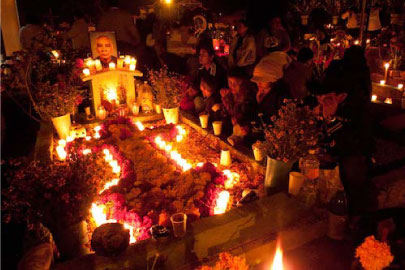
For all of the above, "Los Días de Muertos" represent a mixture of tradition, worship, celebration, magic and history in Oaxaca. It is a magnificent spectacle that is lived in the pantheons; such as the General Pantheon adorned with more than 2,400 candles, or what to say about the Contest of Altars of the Dead, the magnificent ornaments of the tombs, the ingenuity and dedication of the relatives to please the already deceased and all this expression of earthly love.
The City of Oaxaca is preparing for this meeting with the deceased, and in each one of the Pantheons there are activities that each one of us can share, live and experience.

"La Samaritana" Day
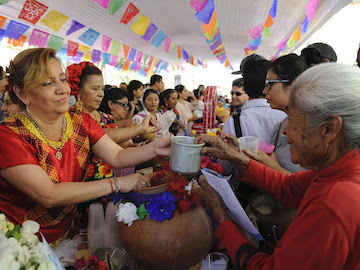
He Samaritan's Day is celebrated during the fourth friday of lent, and tradition indicates that on this day fresh waters and snow should be given. Hundreds of stalls are opened with the flowers that Mexicans love so much and many colored ribbons, and the squares and public spaces are filled with people who want to participate in this tradition. The waters are served from equally decorated pots and no one leaves without having taken at least one glass.
There are no precise data on when this festival was instituted; some people suppose that it was at the time of Christianization (Zúñiga and Aquino, 1989: 39), although it is probable that it was at the end of the 19th century.
It is customary that in the morning of this Friday, in the temples, offices, schools, private houses and some companies fruit water is distributed to those who request it. In the temples it is carried out in their respective atriums and the water begins to be distributed once the priest has imparted the blessing.
Although it takes place in many churches in the city, we cannot say that this is an eminently religious festival, although it may have been in its origins.
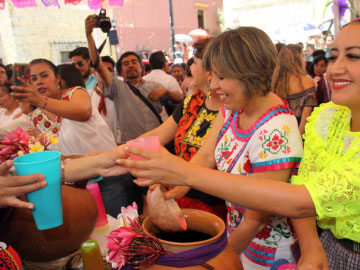
It is said that this tradition possibly began when in the atriums of some churches of the Historic Center the representation of the biblical passage that referred to the encounter of Jesus with the Samaritan woman was performed. Various images were used for this, standing out the one that represented the Samaritan woman, dressed as Oaxacan Chinese.
The most typical flavors in La Samaritana are rice horchata, hibiscus, tuna, among others. Aguas Frescas are also prepared with chilacayota, a very fibrous type of squash that is grown in Oaxaca. The women wear their regional costumes during this beautiful tradition that represents the best of Oaxacan hospitality, courteous and gentle people who like to share with visitors.
It is currently considered a “typical” element of Oaxaca and its success lies in this Folkloric aspect, since the subjects want to participate in that image and contribute to its validity.
Another sample of the generosity that characterizes the Oaxacan people!

Las Calendas
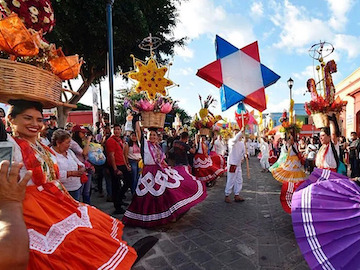
Las Calendas in Oaxaca, whose origin dates back to the 16th century, they are demonstrations where the population is invited to meet and celebrate great events. The patron saint festivities are distinguished by the calendas, which are also seen in other types of celebrations such as baptisms and weddings.
In the different towns of the Oaxacan entity, the calendas are carried out according to the tradition of each community, but it is distinguished by the parade of colors and shapes that invite family and friends to come together and celebrate.
The drum, the rockets, the flowers and the joy of the attendees give life to the calendas, where children, youth, adults and the elderly participate.

Tuesday of «Witches»
This tradition that according to the history of this town has its origins in the colonial era, when the friar Domingo de Santa María, promoted the construction of the Catholic Temple in which the natives of the population participated working night shifts, while the women prepared them bean tamales and atole sweetened with panela.
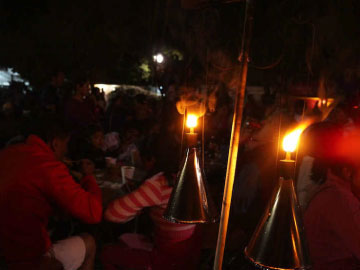
When the sun went down, the wives reached the edges of the trees, lit by ocote torches called “Brujas”, (currently they are containers made of tin with a lighter fueled by oil) where the sound of the snail announced dinner time, and all gathered as one family to share food.
In these times, the xoxeños relive the memories of the rich tamales of great women who inherited their seasoning to their descendants, who today offer tasty bean tamales, rajas, chepil, sweet, mole, the specialty of the house being the chichilo tamale.
Witch Tuesday They are held every Tuesday of the week after Ash Wednesday that marks the beginning of Lent, until Holy WeekIt is a beautiful tradition in which you can enjoy very good concerts or dance while enjoying delicious tamales.

Isthmian Candles
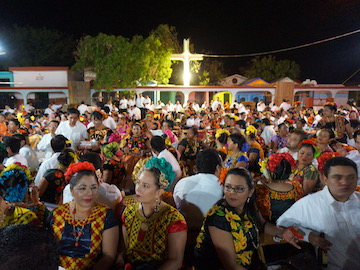
The Isthmian Candles They are originally from the Isthmus of Tehuantepec in honor of the local patron saint and it is organized by one or more mayordomos supported by captains. Masses and parties are organized at the house of the butler and a parade in floats for the "fruit throw", when the women of the Isthmus throw fruits and gifts to the spectators. During the candlelight celebration, the famous calendas are also held, where all the people go out to walk the streets, while they dance, sing and drink. All this is prior to the great dance dinner, where everyone will wear their Isthmian costume to show it off dancing to the sound of the Sandunga (Zandunga).
"May is the month of candles”, They say; however also are held in other months of the year, especially on the days of the patron saints. What is a fact is that it has certain ritual steps that have few variations.
Between the Atlantic and Pacific oceans, the narrowest region of Mexico stands out, but whose cultural wealth is one of the most extensive in the country. It is the Isthmus of Tehuantepec whose folklore and traditions have gone around the world and are an example of Mexican cultural roots.
The Isthmus is rich in diversity, since it is inhabited by Zapotecs, Chontales, Huaves, Toques, Mixes, Mixtecos, Tzotziles and Chinantecos. Each of these ethnic groups arrived in the Oaxaca area in different periods, however, this heterogeneity allowed the Isthmus region to acquire an unequaled cultural wealth.
Origin of the Isthmian Candles
Sheltered by complicity at night, one of the most emblematic traditions of this region stands out: the celebration of the Isthmus candles.
This tradition is full of religious syncretism, since it is carried out in honor of the patron saints of the different towns that make up the Isthmus and whom they honor with devotion during May.
This patronal feast has its origins in pre-Hispanic civilizations, who contributed a unique symbolism to each of the facets.
The Isthmus candles begin with a tour of the main streets of the city and that, generally, culminates in a church.
In this pilgrimage, the women wear the traditional and colorful Tehuana costume and the men a white guayabera and black pants; both walk accompanied by traditional music such as "La Sandunga".
Symbolism of the Isthmian Candles
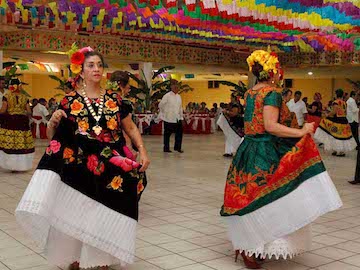
The candle was adopted as the main component, since it is the representation of a sacred element for pre-Hispanic and religious cultures.
The candles were initially used as an offering to the divinities whom they thanked for good harvests, health and life.
However, before the conquest of the Spanish empire in Mexican territory, this tradition, like many others, was adapted to a celebration of saints.
Las Velas Istmeñas
The candles combine in perfect synchrony many of the Mesoamerican offerings with the current customs that were derived from the miscegenation with the Spanish. That is why in some cases, the candle is offered to both a deity and a saint. In total there are 20 types of candles that gracefully adorn the colors of the Oaxacan festival and, although candles are celebrated in all the towns of the Isthmus, there are some that stand out in popularity.
Candle San Vicente Ferrer. This candle is carried out in Juchitán, it is carried out for the whole town and enjoys an incomparable splendor. The celebration includes a mass, a conviviality in the house of the butler, sprinkled with fruit, a bull run, fireworks, an evening and a popular dance. The big candle of San Vicente Ferrer is celebrated the same night in different parts of the city.
Sailing Santo Domingo de Guzmán. Its headquarters is Tehuantepec in honor of the town's patron saint, the inhabitants perform dances, tours wearing traditional costumes and accompanied by the magnificence of the bands of the region.
Saint Jerome Doctor candle. In Ciudad Ixtepec, the candle to San Jerónimo Doctor celebrates festivities offered by butlers, captains, captains and queens.
Candle San Juan. It takes place in the magical town of Espinal in honor of the patron saint San Juan and the Virgen del Rosario.
Biaza candle. It celebrates the Zapotec resurrection, spring, and the nativity of the Virgin Mary.

Bini candle. Dedicated to the goddess Centéotl and the Virgin of the Rosary.
Paloma candle. Offerings are made to Xochiquétzal, a maiden preparing for marriage, to midwives, in autumn, as well as to the Virgin of the Conception. "
Candle San Isidro. Represents the great social event for the Spring Festival, it is the feast of high society families.
Cheguigo candle. The celebration of the candles covers the entire region of the Isthmus of Tehuantepec, from north to south, therefore this candle is the one carried out by those who live on the other side of the river.
Candle San Pedro Cantarito. Dedicated to the city's potters, it should be noted that this tradition had disappeared in 2013, however, jealous generations managed to rescue and preserve it.
Sailing Santa Cruz Guzebenda. Celebrated by the fishing community of the seventh section that year after year show their devotion.
Children's Candle «Guendalizaa Sti Xcuidi». It is intended to promote traditions in the little ones, in this case, as in all others, children wear traditional costumes.
The magic of these celebrations full of tradition surrounds anyone who steps on the Isthmus region in the month of May and who, without a doubt, wants to return to experience the devotion of its inhabitants in the patron saint festivities.

More Tourist Attractions in Oaxaca
The vast Oaxacan cuisine is distinguished by its tradition and the use of regional ingredients. Not for nothing has it positioned itself as the Best Tourist City in the World and the Best Gourmet Destination. In the presentation of the 2021 edition of The Mexico Gastronomic Guide "The Great Restaurants of Mexico" 278 restaurants located throughout the Mexican Republic were recognized, on this occasion, there were 16 Oaxacan restaurants that were placed in the list .
An ideal space for Alternative Tourism, Oaxaca offers activities such as walking, mountain biking, rappelling, climbing, zip-lining, horseback riding, observation of flora and fauna and more, in close contact with nature. The visitor can also witness the various aspects of local life, savor the gastronomy and enjoy the warmth of its people, as well as an offer of accommodation in hotels, ecotourism cabins, local houses or excellent camping areas. In its varied geography, it brings together not only a vast biodiversity, considered among the largest in the world, but also insurmountable cultural and ethnic riches, and the most different and beautiful natural settings.
In Oaxaca we are proud to have 5 communities that have been awarded the title of Magic Towns of Mexico, a Magic Town is a town that has symbolic attributes, legends, history, transcendent events, everyday life, in short magic that they emanate in each of their socio-cultural manifestations, and that today mean a great opportunity for tourist use. The Magical Towns Program contributes to revalue a group of populations in the country that have always been in the collective imagination of the nation as a whole and that represent fresh and different alternatives for national and foreign visitors.
The name mezcal has its roots in one of the ancient native languages of the area and translates as 'agave (also known as maguey) cooked'. Although pre-Hispanic Oaxaqueños used maguey to make pulque (an undistilled alcoholic beverage), it seems that the real advances in mezcal production occurred when the Spanish arrived in Oaxaca; by bringing with them their knowledge of distillation processes.
Oaxaca is famous throughout the world for its archaeological sites and the history they keep. Discover Monte Alban, Mitla, Yagul and more of these remote sites, which have made Oaxaca a World Heritage city, according to Unesco. The original Zapotec and Mixtec peoples of Oaxaca lived in the cities and religious centers of the valley of this city until the time of Spanish colonization. Today, there are still vestiges of these towns and places where you can meet them.
Monte Albán is the most important archaeological zone of the Oaxacan entity, of unique regional importance due to the religious, political and economic control that the Zapotec state exercised over the population of the Valley of Oaxaca for more than thirteen centuries. It has been named by UNESCO as Cultural Heritage of Humanity along with the city of Oaxaca on December 11, 1987. The heritage of the Zapotec world reaches us through the magnificent archaeological sites designed in the Valley of Oaxaca. Of these, the city of Monte Albán stands out for its enormous importance as an economic, political and religious hub (it was the first urban complex in Mesoamerica); by its extension, almost as big as the current capital of Oaxaca; and for its long life, started around 500 BC and concluded around 850 AD
Oaxaca's culinary tradition is extraordinary and deeply rooted. There are fourteen different ethnic groups, with their own dishes. It is an area of incomparable wealth for the tourist interested in gastronomy, ethnology and culture in general. Oaxaca is the land of mezcal, tlayudas and the famous seven moles. You have to dedicate several days to it. Oaxacan gastronomy is one of the cultural manifestations that identify and define its people, due to its variety, richness and complexity that have been preserved through the centuries. The best way to enjoy Oaxacan food is by tasting it, from the “strong” dishes that are used to enjoying at lunchtime; like the traditional Oaxacan snacks that can be enjoyed at any time of the day.
The Santo Domingo Cultural Center is a cultural complex that is located in what was one of the most important convents in the colony. It is a large convent in which the Museum of the Cultures of Oaxaca, the Fray Francisco de Burgoa Library and the Ethnobotanical Garden have been established. The Néstor Sánchez Public Newspaper Library is located in a building that is part of the complex but dates from the 19th century. Apart from all these institutions brought together, the Santo Domingo Cultural Center has multipurpose spaces in the former convent, in which temporary exhibitions, conferences, courses, book presentations and concerts are held, among many other activities.
Crafts in Oaxaca are so varied and of such good quality that they have become a tourist attraction. The ancestral traditions, the diversity in the ethnic groups, as well as the richness in the history of the state have been manifested in the great diversity of creations of more than half a million artisans that are registered in Oaxaca. In the center of the state is the City of Oaxaca, a fascinating and hospitable capital in whose surroundings various towns are located, each with its own personality and craft tradition, accompanied by their respective customs, festivals and dishes.
The City of Oaxaca is a destination that offers a great variety of tourist attractions and charms that leave anyone surprised. However, there are other places that are also worth knowing and are in the surroundings of the city, in whose surroundings various populations are located, each with its own personality and artisan tradition, accompanied by their respective customs, festivals and dishes. .
The beaches of the coast of the state of Oaxaca are among the most beautiful and complete in Mexico, thanks to a developing tourist infrastructure and the rich gastronomy of the Pacific. Along the 533 kilometers of coastline, the beaches of Oaxaca offer a wide variety of activities for lovers of water sports: snorkeling, diving, sport fishing, surfing, among others ... there is something for everyone!
Places such as Puerto Escondido, Mazunte, Zipolite, Carrizalillo, Puerto Ángel or the beaches of Huatulco will offer you the possibility of contemplating beautiful sunsets, delighting in intense adventure tourism or witnessing the exciting release of newborn turtles.
The Guelaguetza is an ancient tradition with pre-Hispanic roots related to agricultural ceremonies of gratitude to the gods for the arrival of the rains and the lifting of the harvest at the end of July and is the largest festival in Oaxaca. La Guelaguetza is a celebration of gratitude for the arrival of the rains and the harvests, in which representatives from all regions of the state gather in the capital to share their culture through dances, crafts and food.
Oaxaca City, the state capital, is famous for its architecture and rich cultural traditions. Oaxaca also has a splendid and varied cuisine and a spring climate throughout the year. UNESCO declared the city a Cultural Heritage of Humanity. Oaxaca is the most diverse state in Mexico. It has peaks that reach more than 3,000 meters in height, caverns that are among the deepest in the world, pristine beaches, secluded forests and sunny valleys. Oaxaca is rich in traditions and customs and has the largest ethnic population in Mexico.

Guided Tours in Oaxaca



